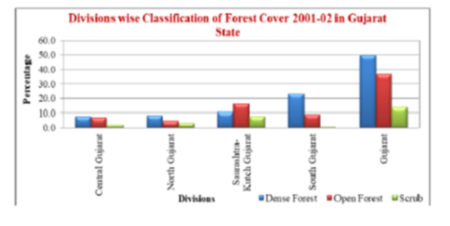
Geo-Eye
Department of Geography & GIS

Department of Geography & GIS

Geo-Eye
Year: 2020, Volume: 9, Issue: 2, Pages: 59-65
Original Article
Holly Dehingia1, P Surendra2
1M.Sc. Student, Department of Geography, Bangalore University, Bengaluru, India
2Assistant Professor, Department of Geography, Bangalore University, Bengaluru, India
Received Date:12 August 2020, Accepted Date:18 November 2020
The Spatio-temporal study can be a significant way for researchers and decision-makers to monitor the status of any particular phenomena or process and so is the study of forest cover. The study reflects how forest cover has changed in different parts of Gujarat and why. The overall objective of this study is to access the Spatio-temporal changes in forest cover in Gujarat. The study is based on data collected from the Gujarat Forest Department and Forest Survey of India. Quantitative techniques were mostly used for the analysis of the data collected from 2001 to 2019. By using simple statistical techniques, it was observed that the forest cover in many areas of Gujarat has been decreasing due to natural causes as well as anthropogenic activities. Tables and figures show the Spatio-temporal changes in forest cover remarkably from 2001-2002, 2010- 2011, and 2018- 2019.
Keywords: Forest cover; temporal changes
© 2020 Dehingia & Surendra. This is an open-access article distributed under the terms of the Creative Commons Attribution License, which permits unrestricted use, distribution, and reproduction in any medium, provided the original author and source are credited.
Published By Bangalore University, Bengaluru, Karnataka
Subscribe now for latest articles and news.